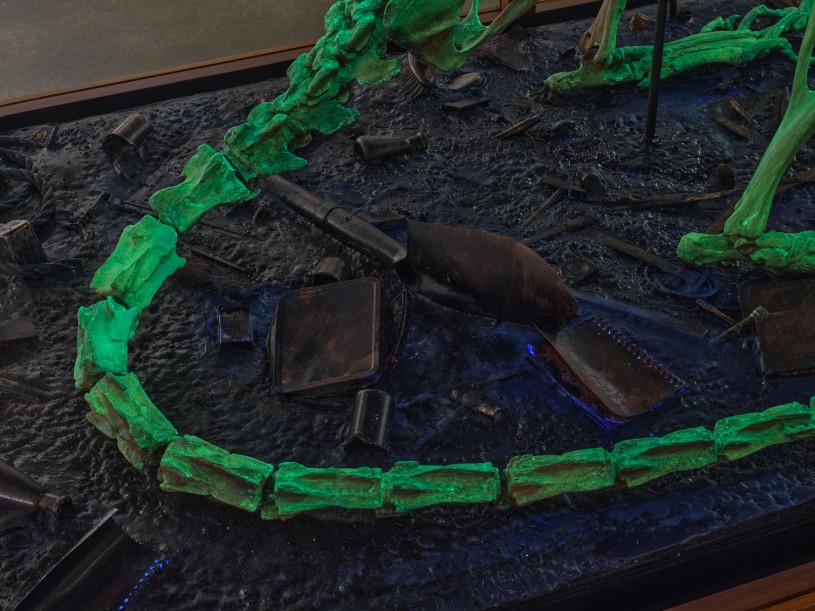Opening September 15, 2024
La Brea Tar Pits
Los Angeles, CA (Sep 04, 2024) – A worktable is strewn with paleontology tools and models, anatomical blackboard drawings of prehistoric animals wrap around the room, and at the center crouches a larger-than-life glow-in-the-dark pack rat.
On view at La Brea Tar Pits for a year beginning September 15, 2024, the exhibition Mark Dion: Excavations is an immersive, uncanny installation of a behind-the-scenes-like museum space. Displaying new work alongside early museum murals, dioramas, and maquettes of Ice Age mammals, this playful, irreverent presentation is in keeping with Dion’s well-known meticulous yet mischievous approach.
The exhibition is centered around a 10-foot-long glow-in-the-dark sculpture of a fossil pack rat skeleton that stands atop a mix of natural and cultural detritus from the Tar Pits excavations and the history of paleontology. Six new anatomical charts by Dion of mammals commonly found in the Tar Pits—artworks labeled with the names of locally important scientists, artists, historical figures, L.A. bands, and landmarks—further blend artifice and reality, revealing Dion’s critical and satirical approach to museum didactics.
In preparation for the exhibition, Dion worked in a multi-year residency at the Tar Pits, Dion assisting with excavations and sorting microfossils and interviewing researchers, educators, and floor staff. At the Natural History Museum, he shadowed a taxidermist and explored collections and archives. He also facilitated the first Tar Pits One Minute Film Festival.
Dion led the creation of an alternative “field guide” to La Brea Tar Pits, published in conjunction with the exhibition. The booklet highlights the site's flora and fauna, as well as the Tar Pits’ unparalleled cultural and scientific significance. It includes essays by La Brea Tar Pits scientists and an intriguing timeline of the area's natural and cultural history created by the artist.
Excavations is among more than 60 exhibitions and programs presented as part of PST ART. Returning in September 2024 with its latest edition, PST ART: Art & Science Collide, this landmark regional event explores the intersections of art and science, both past and present. PST ART is presented by Getty. For more information about PST ART: Art & Science Collide, please visit pst.art. This exhibition is one of two groundbreaking exhibitions hosted by the Natural History Museums of Los Angeles County for this year’s PST ART event. The other is Reframing Dioramas: The Art of Preserving Wilderness at the Natural History Museum in Exposition Park.
About La Brea Tar Pits
La Brea Tar Pits is one of Earth’s most important Ice Age fossil sites. Located in the heart of Los Angeles on Miracle Mile in Hancock Park, the asphalt seeps at La Brea Tar Pits form the only consistently active urban Ice Age excavation site in the world and provide a complete record of the plants and animals that have lived in the L.A. Basin from 50,000 years ago to today. The site is a unique window into active science where fossils are discovered, prepared, researched, and displayed in one place. Outside, visitors can watch excavators unearth fossils of Ice Age plants and animals that were trapped and preserved in the seeps. Inside the museum, scientists and volunteers clean, repair, and identify those fossils. From extraordinary saber-toothed cats, giant sloths, dire wolves, mammoths, and mastodons to microfossils of small animals and plants, the world’s best collection of Ice Age fossils is collected, researched, and displayed all in one extraordinary location. In 2022, La Brea Tar Pits was recognized by UNESCO as a top geological heritage site.
La Brea Tar Pits is part of the Natural History Museums of Los Angeles County (NHMLAC), which also include the Natural History Museum (NHM) in Exposition Park. Welcoming more than 1.2 million visitors annually — including more than 140,000 schoolchildren — the museums and the 35 million objects in their collections offer extensive and comprehensive libraries of natural and cultural history for guests groundbreaking scientific and historical research. NHMLAC also leads the natural and cultural exploration of Los Angeles County, offering a slate of community science and cultural programs both onsite and around the area. The museums help foster revolutionary community partnerships, innovative STEAM pathways, transformative community science programs, and cutting-edge research on climate and global change.
About PST ART: Art & Science Collide
Southern California’s landmark arts event, PST ART, returns in September 2024 with more than 70 exhibitions from museums and other institutions across the region, all exploring the intersections of art and science, both past and present. Dozens of cultural, scientific, and community organizations will join the latest edition, PST ART: Art & Science Collide, with exhibitions on subjects ranging from ancient cosmologies to Indigenous sci-fi, and from environmental justice to artificial intelligence. Art & Science Collide will share groundbreaking research, create indelible experiences for the public, and generate new ways of understanding our complex world. Art & Science Collide follows Pacific Standard Time: LA/LA (September 2017–January 2018), which presented a paradigm-shifting examination of Latin American and Latinx art, and Pacific Standard Time: Art in L.A. 1945–1980 (October 2011–March 2012), which rewrote the history of the birth and impact of the L.A. art scene. PST ART is presented by Getty. For more information about PST ART: Art & Science Collide, please visit: pst.art
MEDIA CONTACTS:
Amy Hood
ahood@nhm.org; 213 763-3532
Josh Chesler
jchesler@nhm.org; 213 763-3580


